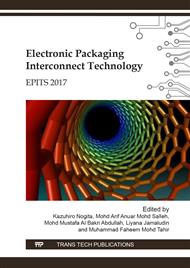p.72
p.77
p.83
p.91
p.95
p.101
p.107
p.115
p.122
STEM Analysis of Atom Location in (Cu, Au, Ni)6Sn5 Intermetallic Compounds
Abstract:
Cu6Sn5 is an important intermetallic compound in soldering and electronic packaging. It is formed at the interface between molten solder and substrate during the soldering process, and the evolution of microstructure and properties also occurs in service. Previous studies revealed that Au and Ni are stabilization alloying elements for hexagonal η-Cu6Sn5 intermetallic. For better understanding of stabilization mechanisms at atomic resolution level, in this work, we made an attempt atomic structure analysis on a stoichiometric (Cu, Au, Ni)6Sn5 intermetallic prepared by direct alloying. High-angle annular dark-field (HAADF) imaging and atomic-resolution chemical mapping were taken by the aberration-corrected (Cs-corrected) scanning transmission electron microscopy (STEM). It is found that Au and Ni doped Cu6Sn5 has hexagonal structure. The atom sites of Cu1 and Sn can be distinguished in atomic-resolution images after being observed from orientation [2110], which is also confirmed by atomic-resolution chemical mapping analysis. Importantly, atomic-resolution about distribution of alloying Au atom was directly observed, and Au atoms occupy the Cu1 sites in η-Cu6Sn5.
Info:
Periodical:
Pages:
95-100
Citation:
Online since:
April 2018
Authors:
Price:
Сopyright:
© 2018 Trans Tech Publications Ltd. All Rights Reserved
Share:
Citation:


